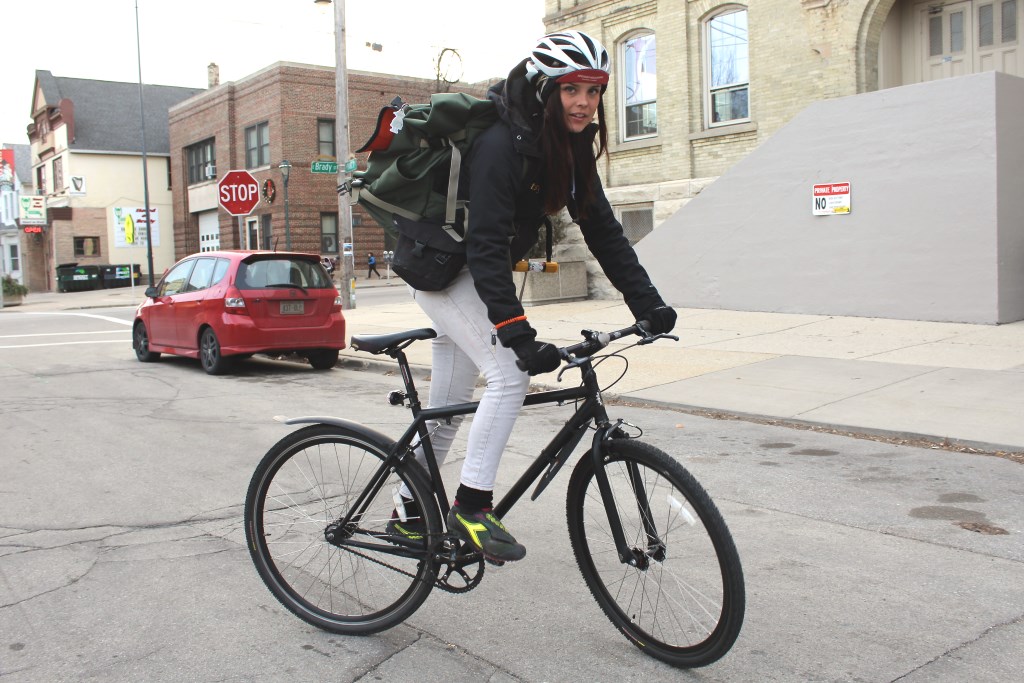10 Tips For Winter Biking
Neither snow nor slush nor freezing temps should stop you, just follow our guide.

Betsy Christensen is a bike courier at Forward and an every day bike commuter. Photo by Emmy A. Yates.
In the normal midwestern fashion, it’s easy to wake up and realize you’re well into your routine of mindlessly coping with a Milwaukee winter. But why not challenge the weather than simply cope with it? Often lost amid the throngs of travelers that rely upon four wheels to commute to work is a rise in the number of two-wheeled winter riders: those brave and adventurous cyclists.
Yes, it can actually be fun. But Wisconsin winters tend to waver between spring-like flirtations and frigid snowpocalypses. So it’s wise to prepare yourself for anything. Here are ten steps that will help keep you riding throughout the winter:
1. The Right Clothing
The first step in becoming a winter bike commuter is letting go of fashion and doing whatever you can to stay warm, dry and flexible. Wearing layers can help you adjust as the day’s weather can change markedly. Different commutes require different gear, but it’s always safe bet to have waterproof gloves, a hat or headband and a scarf or a face mask. Wear water resistant jackets and pants to stay dry when traveling in the sleet or rain. For lower temperatures, wear wool socks and non-cotton base layers for warmth. Ski goggles or clear glasses will prevent those frozen tears on your cheeks and help you see during blizzards or harsh winds.
2. The Right Bike
Salt and constant moisture is hard for a bike and its components. With that in mind, owning a bike that’s able to take a little more wear and tear is something to consider. For those that don’t have a bike set aside, winterizing your current bike is an alternate option. That means swapping components for cheaper parts and investing in a wider tires or studded tires. The snow acts as a blanket on the road, hiding sharp objects that could puncture your tires. Always travel with a extra tubes or patches and a pump to ensure you can still get to where you need to be.
3. See and Be Seen
One of the most important things impacting your safety on the road is how others see you. As the sunlight decreases in overcast days or in late afternoon, your chances of being seen diminish by the hour. Investing in reliable front and rear lights could save your life – don’t go without them.
4. Map Your Path
Winter brings out the reckless in every commuter. Variables like ice and snow create frightening opportunities for you to lose control of your bike, or for a driver to lose control of their car. Educate yourself on routes that have bike lanes and are well-kept.
5. Know Your Local Bike Shop
When your bike’s derailleur breaks or your wheels fall out of true, knowing a skilled mechanic can save your day and your ride. Milwaukee is full of neighborhood bike shops, pro shops and local collectives – find one close to home and make friends with your local mechanic.
6. Find Your Friends
Something that makes a winter commute less miserable is traveling with others. Find friends that are heading in the same direction or who will meet you halfway. Make the best of it by trudging through slush and dirt with someone riding right beside you.
7. No Sudden Moves
Just as if you were on your feet or four wheels; you need to plan ahead when approaching snow, ice and salt. Be mindful that salt and snow can conceal a slippery surface. You’ll need to anticipate breaking earlier, especially when taking sharp turns. Be alert and on the defense when facing other cars – don’t surprise them and hopefully they won’t surprise you.
8. Hydration and Snacks
Just because you’re moving slower on the wintry roads doesn’t mean you’re not susceptible to fatigue and dehydration. Try to keep your snacks in your pockets so they won’t freeze. You can also begin your travels with warm water in your canteen in an effort to make it freeze slower.
9. Don’t Over Think It
Most of the pain in winter biking is mental. Yes, it’s cold, yes, it can be rough going. Probably 90 percent of the work is talking yourself into leaving the warm house. It’s true that once you’re on the bike, it’s not that bad. There’s an element of strength and city slickin’ toughness for those who do it. The rewards are both physical and mental – heck, who doesn’t respect a pedaling icicle?
10. Wear a helmet
Always. The life you save may be your own.
Emmy A. Yates is a freelance writer and bicycle enthusiast
Biking
-
Oak Leaf Trail Projects Could Start in 2024
 Jul 12th, 2023 by Graham Kilmer
Jul 12th, 2023 by Graham Kilmer
-
1896 Bicycle Factory Has Quite A History
 Sep 14th, 2021 by Michael Horne
Sep 14th, 2021 by Michael Horne
-
Honoring Biking Advocate Phil Van Valkenberg
 Jul 31st, 2021 by Spencer Black
Jul 31st, 2021 by Spencer Black



















It’s, uh, March. Super timely article.
@Amanda No doubt we would have liked to get this one out earlier but sometimes things don’t work out as we’d like. But hey it was a bit of a snow shower yesterday so better late than never 🙂
As much as I’m in favor of biking, I really think bad winter weather is NOT for biking. Seeing bikers in falling snow, icy conditions is only asking for an accident to happen. I almost wish bikers would b allowed on sidewalks in less crowded neighborhoods. And please don’t take bike lanes for granted- I’ve seen many drivers use them as if they were passing lanes
Please, please wear reflective clothing. Always! You can get vests that go over clothing. Then keep it with your helmut. And put them both on.
I extremely disagree Micheal…. with a bike properly modified and proper safety gear, winter cycling is as safe as winter driving. In fact, in some conditions, cycling can be easier than driving. That being said there are certain conditions in which I do not venture out, such as ice storms. All of my bone breaking, rib bruising cycling accidents have happened in dry summer weather, not winter riding.
On winter riding advice, make sure to light your bike well also, even more so than summer… I find that clothes that keep the wind off your skin are much more important than clothes that insulate.
Always have a bus pass. Bad conditions can be avoided by this simple alternative.
Thanks for the article. I have been biking through winter every day for 4 years. It gets easier the more you do it. A couple of comments:
#1 I bought some Bar Mitts, this is one product that makes riding through winter comfortable. I also would recommend a good scarf.
#2 Fenders are a good addition to you bike for the winter and rain. After it snows plan on having a place to completely wash off the salt and mess off of your bike.
#5 They are there to help, ask for advice.
#7 This will keep you upright most of the time, just like driving a car you need to take it slow when it is slippery.
#9 As stated above the more you do it the easier it gets.
I ride my commuter all year and I live in Nelson, British Columbia. It’s still snowing here!
I have studded winter tires and they are only 35mm wide on 700 rims. I have lights, fenders (which have 3M reflective strips) and a simple bike computer to know speed and distance travelled. Clothing is a personal preference: my jacket and pants have 3M reflective patches. Bar Mitts as mentioned in one comment keep my hands warm have been an excellent addition to my setup and also have reflective logo. When it’s really cold I ware my snowboard helmet with goggles. Otherwise I use my bike helmet with a thin helmet liner with some clear safety glasses to keep debris out of my eyes along busy roads.
Needless to say winter cycling rocks. I love it. I do take the bus when the snow is too deep but as soon as it’s safe I’m back out on my bike.
Keeping a clean chain and all parts lubed is key to a successful winter on the bike…unless you’re one of those lucky folks with internal hub and belt drive. Then it’s not much concern.